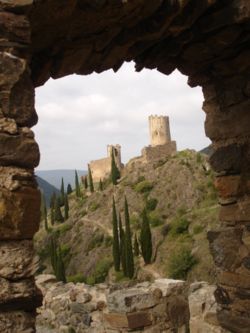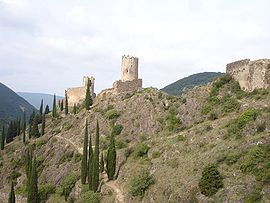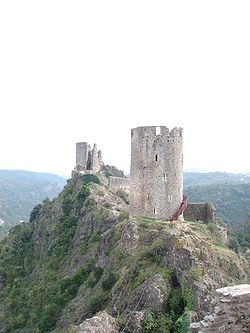
Châteaux de Lastours
Encyclopedia

Cathar
Catharism was a name given to a Christian religious sect with dualistic and gnostic elements that appeared in the Languedoc region of France and other parts of Europe in the 11th century and flourished in the 12th and 13th centuries...
castles in the French commune
Communes of France
The commune is the lowest level of administrative division in the French Republic. French communes are roughly equivalent to incorporated municipalities or villages in the United States or Gemeinden in Germany...
of Lastours
Lastours
Lastours is a commune in the Aude department in southern France.Lastours is located outside Carcassonne, in the valley of the Orbiel. There are 4 small castles each built on a large 300m high rocky ridge. The castles were built to control the access to Montagne Noire and the Cabardes region....
in the département of l'Aude
Aude
Aude is a department in south-central France named after the river Aude. The local council also calls the department "Cathar Country".Aude is also a frequent feminine French given name in Francophone countries, deriving initially from Aude or Oda, a wife of Bertrand, Duke of Aquitaine, and mother...
. The four castles are on a rocky spur above the village of Lastours, isolated by the deep valleys of the Orbeil and Grésilhou rivers. They were built at an altitude of 300 m along a rock wall just 1300 feet (~400 m) long by 165 feet (~50 m) wide. Cabaret, Surdespine and la Tour Régine stand in line, while Quertinheux is built on a separate pinnacle close by. The site has been classified monument historique
Monument historique
A monument historique is a National Heritage Site of France. It also refers to a state procedure in France by which national heritage protection is extended to a building or a specific part of a building, a collection of buildings, or gardens, bridges, and other structures, because of their...
(historic monument) by the French Ministry of Culture since 1905 and archaeological digs are still in progress.
These four castles constitute a single entity, even though they are not a single structure. The natural layout of the site permitted the economy of a fortress of great height. Plans were adapted to the rocks on which they were built. The construction of each is different reflecting the range of alterations made to the castles.
History

Middle Ages
The Middle Ages is a periodization of European history from the 5th century to the 15th century. The Middle Ages follows the fall of the Western Roman Empire in 476 and precedes the Early Modern Era. It is the middle period of a three-period division of Western history: Classic, Medieval and Modern...
, the site belonged to the lords of Cabaret, mentioned for the first time in 1067. Their wealth came mainly from the exploitation of iron
Iron
Iron is a chemical element with the symbol Fe and atomic number 26. It is a metal in the first transition series. It is the most common element forming the planet Earth as a whole, forming much of Earth's outer and inner core. It is the fourth most common element in the Earth's crust...
mines. Probably only three castles were built in the 11th century and their sites evolved over the years following demolition and successive rebuilding. During this period, there were at least 22 lords of Cabaret.
The castles lived through the Albigensian crusade
Albigensian Crusade
The Albigensian Crusade or Cathar Crusade was a 20-year military campaign initiated by the Catholic Church to eliminate Catharism in Languedoc...
. Indeed, the lords of Cabaret were closely linked to the followers of Catharism. The villages surrounding the castles welcomed many Cathars. The fortress at this time belonged to Pierre-Roger de Cabaret follower of Raymond-Roger de Trencavel
Raymond-Roger de Trencavel
Raymond Roger Trencavel was a member of the noble Trencavel family. He was viscount of Béziers and Albi , and viscount of Carcassonne and the Razès .Raymond-Roger was the son of Roger II Trencavel Raymond Roger Trencavel (also Raimond, ; 1185 – 10 November 1209) was a member of the noble...
, who fought at his side during the defence of Carcassonne
Carcassonne
Carcassonne is a fortified French town in the Aude department, of which it is the prefecture, in the former province of Languedoc.It is divided into the fortified Cité de Carcassonne and the more expansive lower city, the ville basse. Carcassone was founded by the Visigoths in the fifth century,...
. In 1209, the site resisted the attacks of Simon de Montfort, 5th Earl of Leicester
Simon de Montfort, 5th Earl of Leicester
Simon IV de Montfort, Seigneur de Montfort-l'Amaury, 5th Earl of Leicester , also known as Simon de Montfort the elder, was a French nobleman who took part in the Fourth Crusade and was a prominent leader of the Albigensian Crusade...
. But the crusader Bouchard de Marly, then lord of the Château de Saissac
Château de Saissac
The Château de Saissac is a ruined Cathar castle in the southernmost tip of the commune of Saissac in the Aude département in the north-west of Carcassonne, France. It was once the residence of the powerful vassal family of Trencavel...
, was taken prisoner by Pierre-Roger. His freedom was negotiated against the surrender of Cabaret in 1211.
In 1223, the lords of Cabaret repossessed their lands and Cabaret became the seat of the Cathar bishop of Carcassès. Pierre-Roger resisted Simon de Montfort's attacks for many years, but in 1227, the castles were again besieged by Humbert de Beaujeu. In 1229, Cabaret capitulated.
The villages and the castles were plundered and then rebuilt to become royal fortresses. The Tour Régine was built by order of the king to affirm his supremacy. They became the administrative and military centre of six communities forming the châtellerie of Cabardès. In the 16th century, the castles were occupied by Protestants. They were dislodged by maréchal de Joyeuse in 1591.
Organisation in the 11th century
Before the Crusade against the Albigensians, there were only three castles and they were not arranged on the crest. The surrounding villages were similar: houses, forges and cisterns around a high, narrow keepKeep
A keep is a type of fortified tower built within castles during the Middle Ages by European nobility. Scholars have debated the scope of the word keep, but usually consider it to refer to large towers in castles that were fortified residences, used as a refuge of last resort should the rest of the...
. Traces of the villages can be found on the west flank of the hill arranged in a semicircle following the contours around the manor house.
In the 13th century, the king decided on the destruction of the three towers and their houses so as to eliminate all refuges for the Cathars. The castles, however, were rebuilt on the crest so as to make them less accessible to enemy fire.
Catharism at Cabaret
The castles at Latours were a centre of Cathar religious activity during the 13th century. The castle village sheltered numerous 'PerfectsCathar Perfect
Perfect was the name given to a monk of the medieval French Christian religious movement commonly referred to as the Cathars. The term reflects that such a person was seen by the Catholic Church as the "perfect heretic"...
' homes and the Cathar bishops went to stay in Cabaret: Arnaud Hot, Pierre Isarn and Guiraud Abith. In 1229, the fortress launched the Cathar resistance in the Languedoc
Languedoc
Languedoc is a former province of France, now continued in the modern-day régions of Languedoc-Roussillon and Midi-Pyrénées in the south of France, and whose capital city was Toulouse, now in Midi-Pyrénées. It had an area of approximately 42,700 km² .-Geographical Extent:The traditional...
. This period was called the Guerre de Cabaret (War of Cabaret).
The Lastours castles held out as a centre of opposition to the conquests of Simon de Montfort, who determined to wipe them out. In this, he was bound to fail, having to launch simultaneous attacks on three castles protected by sheer rockfaces and defended by a nobleman who, though not a Cathar, was aware of the importance of the campaign de Montfort was waging against his suzerain, the viscount of Carcassonne. De Montfort decided against attacking the castles and instead resorted to a cruel ploy that typifies the barbarity of this war. He brought prisoners from the village of Bram and had their eyes gouged out and their ears, noses and lips cut off. One prisoner, left with a single good eye, led them to Lastours as a warning. The ploy failed; the castles put up more resistance and held out until the supposedly impregnable fortress at Termes
Château de Termes
The Château de Termes is a ruined castle near the village of Termes in the Aude département of France. It is one of the so-called Cathar castles.-History:...
fell in November 1210. The lord of Cabaret then surrendered.
Present description

Cabaret 43°20′16"N 2°22′39.5"E
- Cabaret castle is the main citadelCitadelA citadel is a fortress for protecting a town, sometimes incorporating a castle. The term derives from the same Latin root as the word "city", civis, meaning citizen....
with a barbicanBarbicanA barbican, from medieval Latin barbecana, signifying the "outer fortification of a city or castle," with cognates in the Romance languages A barbican, from medieval Latin barbecana, signifying the "outer fortification of a city or castle," with cognates in the Romance languages A barbican, from...
defence system. It consists of a north tower, a polygonal keep in the south and a group of residential buildings in the centre. The whole is surrounded by ramparts with a round walk. The crenellated wall is built with irregular material, with large stones forming the corners and openings.
Tour Régine 43°20′13.2"N 2°22′40.2"E
- The Tour Régine, closest to Cabaret, (Régine Tower) is the most recent fortress and the smallest. It consists of a round tower, surrounded by a small curtain wall which has collapsed. Below ground, the tower contains the largest cistern of the four castles. The tower has three storeys and is flanked by a spiral staircase. The white limestone used is identical to that at Cabaret. It is thought that this tower was built after the Albigensian CrusadeAlbigensian CrusadeThe Albigensian Crusade or Cathar Crusade was a 20-year military campaign initiated by the Catholic Church to eliminate Catharism in Languedoc...
: the name (Régine = Royal) suggests as much and there is no written evidence of its existence prior to 1260.
Surdespine 43°20′11"N 2°22′42"E
- Also called Fleur-Espine (Thornflower), this castle is the least preserved of the four. On the highest part of the site, it consists of a square tower, a house and a cistern. A rectangular curtain wall gives protection. It is noted for the rarity of its murder holes and its four semicircular arched windows.
Quertinheux 43°20′7.8"N 2°22′38.5"E
- The Quertinheux castle is furthest south along the crest on an isolated rocky outcrop. It consists of a circular tower and a polygonal curtain wall. A chicane defends the entrance. It overlooks the remains of a destroyed RomanesqueRomanesque architectureRomanesque architecture is an architectural style of Medieval Europe characterised by semi-circular arches. There is no consensus for the beginning date of the Romanesque architecture, with proposals ranging from the 6th to the 10th century. It developed in the 12th century into the Gothic style,...
church.

